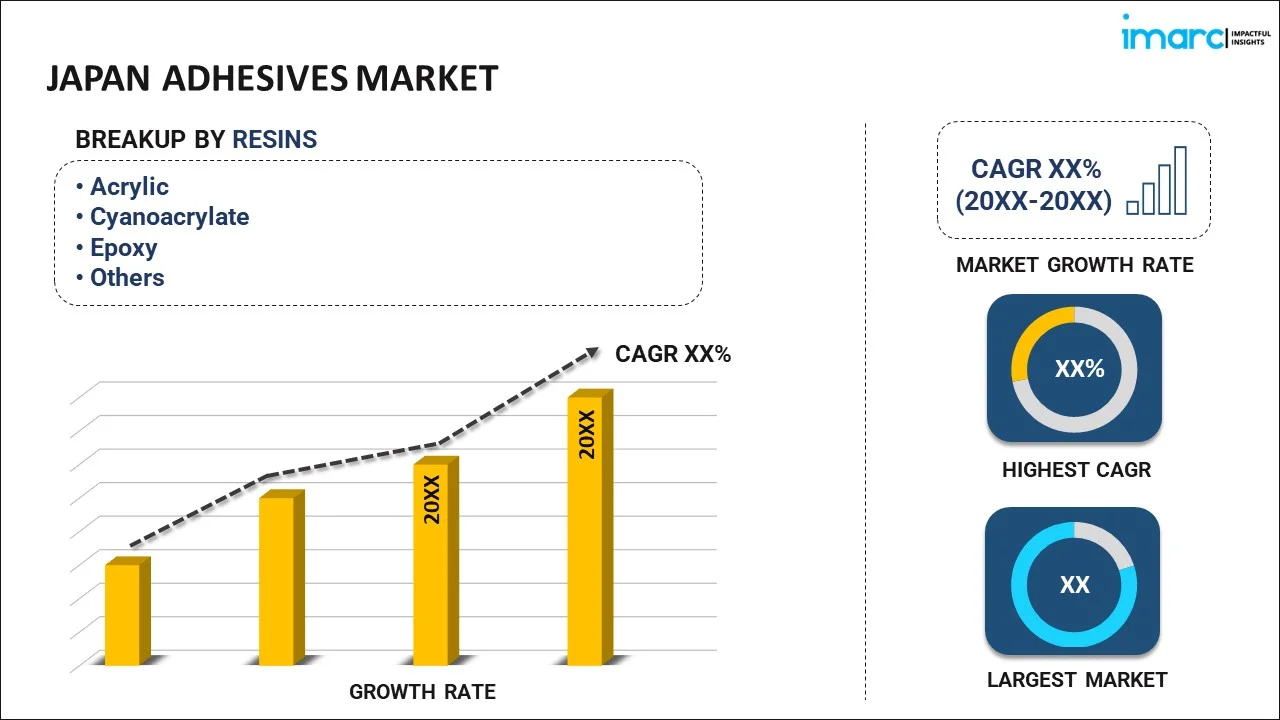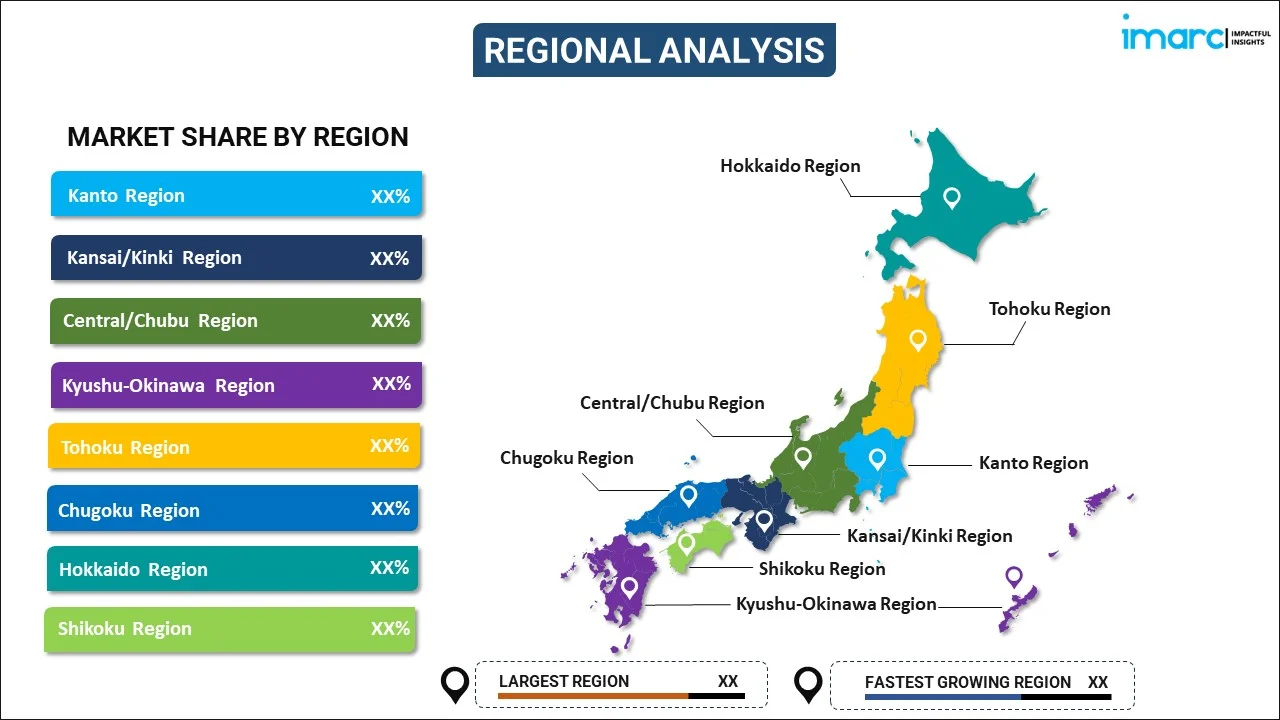
Japan Adhesives Market Report by Resin (Acrylic, Cyanoacrylate, Epoxy, Polyurethane, Silicone, VAE/EVA, and Others), Technology (Hot Melt, Reactive, Solvent-borne, UV Cured Adhesives, Water-borne), End Use Industry (Aerospace, Automotive, Building and Construction, Footwear and Leather, Healthcare, Packaging, Woodworking and Joinery, and Others), and Region 2025-2033
Market Overview:
Japan adhesives market size reached USD 2.2 Billion in 2024. Looking forward, IMARC Group expects the market to reach USD 3.4 Billion by 2033, exhibiting a growth rate (CAGR) of 4.9% during 2025-2033. The ongoing infrastructural development, coupled with the launch of innovative products like high-performance and environmentally friendly water-based adhesives, is primarily driving the market growth.
|
Report Attribute
|
Key Statistics
|
|---|---|
|
Base Year
|
2024
|
|
Forecast Years
|
2025-2033
|
|
Historical Years
|
2019-2024
|
|
Market Size in 2024
|
USD 2.2 Billion |
|
Market Forecast in 2033
|
USD 3.4 Billion |
| Market Growth Rate 2025-2033 | 4.9% |
Adhesives are substances that are integral to various manufacturing and construction processes, enabling the binding of different materials through surface attachment. They come in several forms, including glues, pastes, tapes, etc., and can be designed to meet specific bonding requirements, depending on the materials utilized and the conditions of the environment they are exposed to. Adhesives can create bonds that are stronger and more flexible than other joining methods, such as welding or bolting, making them indispensable in numerous applications. These remarkable substances have a broad spectrum of uses, ranging from household repairs to sophisticated industrial assemblies. Produced via significant advancements in chemistry and materials science, adhesives continue to evolve, offering innovative solutions to bonding challenges and playing a crucial role in the development of products in industries, such as automotive, aerospace, medical, consumer goods, etc.
Japan Adhesives Market Trends:
The Japan adhesives market is experiencing significant evolution, marked by novel trends and market drivers. One of the primary factors is the escalating demand for eco-friendly or green sticking agents, owing to the stringent regulatory frameworks set by government bodies focusing on sustainability. Additionally, the widespread adoption of bio-based adhesives, which have a reduced carbon footprint, is acting as another significant growth-inducing factor. Besides this, the rising inclination among leading manufacturers towards technologically advanced sticking agents that offer superior bonding solutions, enhanced durability, optimal resilience, etc., is positively influencing the regional market. Moreover, the expanding automotive industry, where the need for high-performance adhesives is paramount, is further bolstering the market growth across Japan. Apart from this, with the inflating popularity of lightweight and fuel-efficient vehicles, there is a growing requirement of advanced product variants that can bond diverse materials effectively. Furthermore, the elevating usage of these substances in the packaging industry for sealing and labeling is another pivotal driver. As such, numerous innovations in the medical field are propelling the demand for medical-grade adhesives in wound care, which is expected to fuel the Japan adhesives market in the coming years.
Japan Adhesives Market Segmentation:
IMARC Group provides an analysis of the key trends in each segment of the market, along with forecasts at the country level for 2025-2033. Our report has categorized the market based on resin, technology, and end use industry.
Resin Insights:

- Acrylic
- Cyanoacrylate
- Epoxy
- Polyurethane
- Silicone
- VAE/EVA
- Others
The report has provided a detailed breakup and analysis of the market based on the resin. This includes acrylic, cyanoacrylate, epoxy, polyurethane, silicone, VAE/EVA, and others.
Technology Insights:
- Hot Melt
- Reactive
- Solvent-borne
- UV Cured Adhesives
- Water-borne
A detailed breakup and analysis of the market based on the technology have also been provided in the report. This includes hot melt, reactive, solvent-borne, UV cured adhesives, and water-borne.
End Use Industry Insights:
- Aerospace
- Automotive
- Building and Construction
- Footwear and Leather
- Healthcare
- Packaging
- Woodworking and Joinery
- Others
The report has provided a detailed breakup and analysis of the market based on the end use industry. This includes aerospace, automotive, building and construction, footwear and leather, healthcare, packaging, woodworking and joinery, and others.
Regional Insights:

- Kanto Region
- Kansai/Kinki Region
- Central/ Chubu Region
- Kyushu-Okinawa Region
- Tohoku Region
- Chugoku Region
- Hokkaido Region
- Shikoku Region
The report has also provided a comprehensive analysis of all the major regional markets, which include Kanto Region, Kansai/Kinki Region, Central/ Chubu Region, Kyushu-Okinawa Region, Tohoku Region, Chugoku Region, Hokkaido Region, and Shikoku Region.
Competitive Landscape:
The market research report has also provided a comprehensive analysis of the competitive landscape. Competitive analysis such as market structure, key player positioning, top winning strategies, competitive dashboard, and company evaluation quadrant has been covered in the report. Also, detailed profiles of all major companies have been provided. Some of the key players include:
- 3M Company
- AICA Kogyo Co. Ltd.
- Arkema S.A.
- CEMEDINE Co. Ltd. (Kaneka Corporation)
- H.B. Fuller Company
- Henkel AG & Co. KGaA
- Sika AG
- The Yokohama Rubber Co. Ltd. (Furukawa Group)
- Toyochem Co. Ltd. (Toyo Ink Mfg. Co. Ltd.)
(Please note that this is only a partial list of the key players, and the complete list is provided in the report.)
Japan Adhesives Market Report Coverage:
| Report Features | Details |
|---|---|
| Base Year of the Analysis | 2024 |
| Historical Period | 2019-2024 |
| Forecast Period | 2025-2033 |
| Units | Billion USD |
| Scope of the Report | Exploration of Historical Trends and Market Outlook, Industry Catalysts and Challenges, Segment-Wise Historical and Future Market Assessment:
|
| Resins Covered | Acrylic, Cyanoacrylate, Epoxy, Polyurethane, Silicone, VAE/EVA, Others |
| Technologies Covered | Hot Melt, Reactive, Solvent-borne, UV Cured Adhesives, Water-borne |
| End Use Industries Covered | Aerospace, Automotive, Building and Construction, Footwear and Leather, Healthcare, Packaging, Woodworking and Joinery, Others |
| Regions Covered | Kanto Region, Kansai/Kinki Region, Central/ Chubu Region, Kyushu-Okinawa Region, Tohoku Region, Chugoku Region, Hokkaido Region, Shikoku Region |
| Companies Covered | 3M Company, AICA Kogyo Co. Ltd., Arkema S.A., CEMEDINE Co. Ltd. (Kaneka Corporation), H.B. Fuller Company, Henkel AG & Co. KGaA, Sika AG, The Yokohama Rubber Co. Ltd. (Furukawa Group), Toyochem Co. Ltd. (Toyo Ink Mfg. Co. Ltd.) |
| Customization Scope | 10% Free Customization |
| Post-Sale Analyst Support | 10-12 Weeks |
| Delivery Format | PDF and Excel through Email (We can also provide the editable version of the report in PPT/Word format on special request) |
Key Questions Answered in This Report:
- How has the Japan adhesive market performed so far and how will it perform in the coming years?
- What has been the impact of COVID-19 on the Japan adhesives market?
- What is the breakup of the Japan adhesives market on the basis of resin?
- What is the breakup of the Japan adhesives market on the basis of technology?
- What is the breakup of the Japan adhesives market on the basis of end use industry?
- What are the various stages in the value chain of the Japan adhesives market?
- What are the key driving factors and challenges in the Japan adhesive?
- What is the structure of the Japan adhesives market and who are the key players?
- What is the degree of competition in the Japan adhesives market?
Key Benefits for Stakeholders:
- IMARC’s industry report offers a comprehensive quantitative analysis of various market segments, historical and current market trends, market forecasts, and dynamics of the Japan adhesives market from 2019-2033.
- The research report provides the latest information on the market drivers, challenges, and opportunities in the Japan adhesives market.
- Porter's five forces analysis assist stakeholders in assessing the impact of new entrants, competitive rivalry, supplier power, buyer power, and the threat of substitution. It helps stakeholders to analyze the level of competition within the Japan adhesives industry and its attractiveness.
- Competitive landscape allows stakeholders to understand their competitive environment and provides an insight into the current positions of key players in the market.
Need more help?
- Speak to our experienced analysts for insights on the current market scenarios.
- Include additional segments and countries to customize the report as per your requirement.
- Gain an unparalleled competitive advantage in your domain by understanding how to utilize the report and positively impacting your operations and revenue.
- For further assistance, please connect with our analysts.
 Inquire Before Buying
Inquire Before Buying
 Speak to an Analyst
Speak to an Analyst
 Request Brochure
Request Brochure
 Request Customization
Request Customization




.webp)




.webp)












